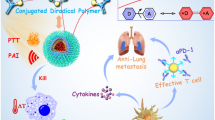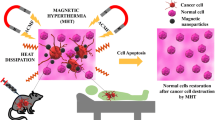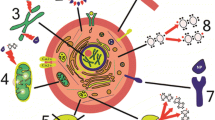Abstract
Thermosensitive drug delivery systems (DDSs) face major challenges, such as remote and repeatable control of in vivo temperature, although these can increase the therapeutic efficacy of drugs. To address this issue, we coated near-infrared (NIR) photothermal Cu1.75S nanocrystals with pH/thermos-sensitive polymer by in situ polymerization. The doxorubicine (DOX) loading content was up to 40 wt.%, with less than 8.2 wt.% of DOX being leaked under normal physiological conditions (pH = 7.4, 37 °C) for almost 48 h in the absence of NIR light. These nanocapsules demonstrate excellent photothermal stability by continuous longterm NIR irradiation. Based on the stable and high photothermal efficiency (55.8%), pre-loaded drugs were released as desired using 808-nm light as a trigger. Both in vitro and in vivo antitumor therapy results demonstrated that this smart nanoplatform is an effective agent for synergistic hyperthermia-based chemotherapy of cancer, demonstrating remote and noninvasive control.

Similar content being viewed by others
References
Peng, Z. Y.; Qin, J. B.; Li, B.; Ye, K. C.; Zhang, Y. X.; Yang, X. R.; Yuan, F. K.; Huang, L. J.; Hu, J. Q.; Lu, X. W. An effective approach to reduce inflammation and stenosis in carotid artery: Polypyrrole nanoparticle-based photothermal therapy. Nanoscale 2015, 7, 7682–7691.
Hu, X. L.; Liu, G. H.; Li, Y.; Wang, X. R.; Liu, S. Y. Cell-penetrating hyperbranched polyprodrug amphiphiles for synergistic reductive milieu-triggered drug release and enhanced magnetic resonance signals. J. Am. Chem. Soc. 2015, 137, 362–368.
Huang, S.; Peng, S.; Li, Y. B.; Cui, J. B.; Chen, H. L.; Wang, L. Y. Development of NIR-II fluorescence image-guided and pH-responsive nanocapsules for cocktail drug delivery. Nano Res. 2015, 8, 1932–1943.
He, Q.; Huang, S.; Xu, S. Y.; Wang, L. Y. pH-responsive cocktail drug nanocarriers by encapsulating paclitaxel with doxorubicin modified poly(amino acid). RSC Adv. 2015, 5, 43148–43154.
Bai, X. L.; Wang, S. G.; Xu, S. Y.; Wang, L. Y. Luminescent nanocarriers for simultaneous drug or gene delivery and imaging tracking. TrAC-Trends Anal. Chem. 2015, 73, 54–63.
Bai, M.; Bai, X. L.; Wang, L. Y. Real-time fluorescence tracking of gene delivery via multifunctional nanocomposites. Anal. Chem. 2014, 86, 11196–11202.
Li, X. M.; Zhou, L.; Wei, Y.; El-Toni, A. M.; Zhang, F.; Zhao, D. Y. Anisotropic growth-induced synthesis of dualcompartment janus mesoporous silica nanoparticles for bimodal triggered drugs delivery. J. Am. Chem. Soc. 2014, 136, 15086–15092.
Xiao, Q. F.; Zheng, X. P.; Bu, W. B.; Ge, W. Q.; Zhang, S. J.; Chen, F.; Xing, H. Y.; Ren, Q. G.; Fan, W. P.; Zhao, K. L. et al. A core/satellite multifunctional nanotheranostic for in vivo imaging and tumor eradication by radiation/photothermal synergistic therapy. J. Am. Chem. Soc. 2013, 135, 13041–13048.
Kong, S. D.; Zhang, W. Z.; Lee, J. H.; Brammer, K.; Lal, R.; Karin, M.; Jin, S. H. Magnetically vectored nanocapsules for tumor penetration and remotely switchable on-demand drug release. Nano Lett. 2010, 10, 5088–5092.
Nakayama, M.; Okano, T.; Miyazaki, T.; Kohori, F.; Sakai, K.; Yokoyama, M. Molecular design of biodegradable polymeric micelles for temperature-responsive drug release. J. Control. Release 2006, 115, 46–56.
Zhang, Z. J.; Wang, J.; Nie, X.; Wen, T.; Ji, Y. L.; Wu, X. C.; Zhao, Y. L.; Chen, C. Y. Near infrared laser-induced targeted cancer therapy using thermoresponsive polymer encapsulated gold nanorods. J. Am. Chem. Soc. 2014, 136, 7317–7326.
Yavuz, M. S.; Cheng, Y. Y.; Chen, J. Y.; Cobley, C. M.; Zhang, Q.; Rycenga, M.; Xie, J. W.; Kim, C.; Song, K. H.; Schwartz, A. G. et al. Gold nanocages covered by smart polymers for controlled release with near-infrared light. Nat. Mater. 2009, 8, 935–939.
Kumar, A.; Kumar, S.; Rhim, W. K.; Kim, G. H.; Nam, J. M. Oxidative nanopeeling chemistry-based synthesis and photodynamic and photothermal therapeutic applications of plasmonic core-petal nanostructures. J. Am. Chem. Soc. 2014, 136, 16317–16325.
Xu, Y. Y.; Wang, J.; Li, X. F.; Liu, Y.; Dai, L. R.; Wu, X. C.; Chen, C. Y. Selective inhibition of breast cancer stem cells by gold nanorods mediated plasmonic hyperthermia. Biomaterials 2014, 35, 4667–4677.
Skrabalak, S. E.; Chen, J. Y.; Sun, Y. G.; Lu, X. M.; Au, L.; Cobley, C. M.; Xia, Y. N. Gold nanocages: Synthesis, properties, and applications. Accounts Chem. Res. 2008, 41, 1587–1595.
Ma, Y.; Liang, X. L.; Tong, S.; Bao, G.; Ren, Q. S.; Dai, Z. F. Gold nanoshell nanomicelles for potential magnetic resonance imaging, light-triggered drug release, and photothermal therapy. Adv. Funct. Mater. 2013, 23, 815–822.
Ye, E. Y.; Win, K. Y.; Tan, H. R.; Lin, M.; Teng, C. P.; Mlayah, A.; Han, M. Y. Plasmonic gold nanocrosses with multidirectional excitation and strong photothermal effect. J. Am. Chem. Soc. 2011, 133, 8506–8509.
Wang, C.; Xu, L. G.; Liang, C.; Xiang, J.; Peng, R.; Liu, Z. Immunological responses triggered by photothermal therapy with carbon nanotubes in combination with anti-CTLA-4 therapy to inhibit cancer metastasis. Adv. Mater. 2014, 26, 8154–8162.
Robinson, J. T.; Tabakman, S. M.; Liang, Y. Y.; Wang, H. L.; Casalongue, H. S.; Vinh, D.; Dai, H. J. Ultrasmall reduced graphene oxide with high near-infrared absorbance for photothermal therapy. J. Am. Chem. Soc. 2011, 133, 6825–6831.
Cheng, L.; Liu, J. J.; Gu, X.; Gong, H.; Shi, X. Z.; Liu, T.; Wang, C.; Wang, X. Y.; Liu, G.; Xing, H. Y. et al. PEGylated WS2 nanosheets as a multifunctional theranostic agent for in vivo dual-modal CT/photoacoustic imaging guided photothermal therapy. Adv. Mater. 2014, 26, 1886–1893.
Chou, S. S.; Kaehr, B.; Kim, J.; Foley, B. M.; De, M.; Hopkins, P. E.; Huang, J. X.; Brinker, C. J.; Dravid, V. P. Chemically exfoliated MoS2 as near-infrared photothermal agents. Angew. Chem., Int. Ed. 2013, 52, 4160–4164.
Tian, Q. W.; Jiang, F. R.; Zou, R. J.; Liu, Q.; Chen, Z. G.; Zhu, M. F.; Yang, S. P.; Wang, J. L.; Wang, J. H.; Hu, J. Q. Hydrophilic Cu9S5 nanocrystals: A photothermal agent with a 25.7% heat conversion efficiency for photothermal ablation of cancer cells in vivo. ACS Nano 2011, 5, 9761–9771.
Tian, Q. W.; Tang, M. H.; Sun, Y. G.; Zou, R. J.; Chen, Z. G.; Zhu, M. F.; Yang, S. P.; Wang, J. L.; Wang, J. H.; Hu, J. Q. Hydrophilic flower-like CuS superstructures as an efficient 980 nm laser-driven photothermal agent for ablation of cancer cells. Adv. Mater. 2011, 23, 3542–3547.
Cui, J. B.; Li, Y. J.; Liu, L.; Chen, L.; Xu, J.; Ma, J. W.; Fang, G.; Zhu, E. B.; Wu, H.; Zhao, L. X. et al. Near-infrared plasmonic-enhanced solar energy harvest for highly efficient photocatalytic reactions. Nano Lett. 2015, 15, 6295–6301.
Cui, J. B.; Jiang, R.; Xu, S. Y.; Hu, G. F.; Wang, L. Y. Cu7S4 nanosuperlattices with greatly enhanced photothermal efficiency. Small 2015, 11, 4183–4190.
Xie, Y.; Carbone, L.; Nobile, C.; Grillo, V.; D'Agostino, S.; Della Sala, F.; Giannini, C.; Altamura, D.; Oelsner, C.; Kryschi, C. et al. Metallic-like stoichiometric copper sulfide nanocrystals: Phase- and shape-selective synthesis, nearinfrared surface plasmon resonance properties, and their modeling. ACS Nano 2013, 7, 7352–7369.
Zhao, Y. X.; Pan, H. C.; Lou, Y. B.; Qiu, X. F.; Zhu, J. J.; Burda, C. Plasmonic Cu2–xS nanocrystals: Optical and structural properties of copper-deficient copper(I) sulfides. J. Am. Chem. Soc. 2009, 131, 4253–4261.
Ding, X. G.; Liow, C. H.; Zhang, M. X.; Huang, R. J.; Li, C. Y.; Shen, H.; Liu, M. Y.; Zou, Y.; Gao, N.; Zhang, Z. J. et al. Surface plasmon resonance enhanced light absorption and photothermal therapy in the second near-infrared window. J. Am. Chem. Soc. 2014, 136, 15684–15693.
Mountain, B. W.; Seward, T. M. Hydrosulfide/sulfide complexes of copper(I): Experimental confirmation of the stoichiometry and stability of Cu(HS)2–to elevated temperatures. Geochim. Cosmochim. Acta 2003, 67, 3005–3014.
Hessel, C. M.; Pattani, V. P.; Rasch, M.; Panthani, M. G.; Koo, B.; Tunnell, J. W.; Korgel, B. A. Copper selenide nanocrystals for photothermal therapy. Nano Lett. 2011, 11, 2560–2566.
Shi, J. J.; Wang, L.; Zhang, J.; Ma, R.; Gao, J.; Liu, Y.; Zhang, C. F.; Zhang, Z. Z. A tumor-targeting near-infrared laser-triggered drug delivery system based on GO@Ag nanoparticles for chemo-photothermal therapy and X-ray imaging. Biomaterials 2014, 35, 5847–5861.
Roper, D. K.; Ahn, W.; Hoepfner, M. Microscale heat transfer transduced by surface plasmon resonant gold nanoparticles. J. Phys. Chem. C 2007, 111, 3636–3641.
Li, B.; Wang, Q.; Zou, R. J.; Liu, X. J.; Xu, K. B.; Li, W. Y.; Hu, J. Q. Cu7.2S4 nanocrystals: A novel photothermal agent with a 56.7% photothermal conversion efficiency for photothermal therapy of cancer cells. Nanoscale 2014, 6, 3274–3282.
Kim, H.; Lee, D.; Kim, J.; Kim, T. I.; Kim, W. J. Photothermally triggered cytosolic drug delivery via endosome disruption using a functionalized reduced graphene oxide. ACS Nano 2013, 7, 6735–6746.
Author information
Authors and Affiliations
Corresponding authors
Electronic supplementary material
Rights and permissions
About this article
Cite this article
Huang, S., Liu, J., He, Q. et al. Smart Cu1.75S nanocapsules with high and stable photothermal efficiency for NIR photo-triggered drug release. Nano Res. 8, 4038–4047 (2015). https://doi.org/10.1007/s12274-015-0905-9
Received:
Revised:
Accepted:
Published:
Issue Date:
DOI: https://doi.org/10.1007/s12274-015-0905-9




